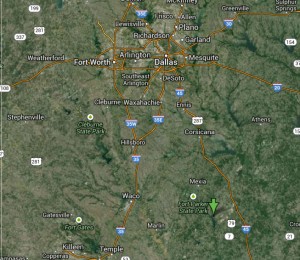Archive for December 2013
D Day (Drilling Day) Minus 8: Latest on Dallas Gas Ordinance
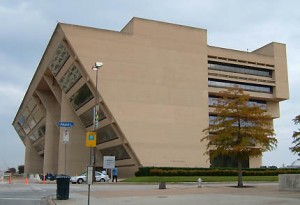 If you can, please be sure and attend and speak-up during the public comment time being offered by the Dallas City Council today at 1 pm. Although hastily-called on the day before Thanksgiving, this "unofficial" hearing is a chance for you to speak to Council Members while things still seem to be in motion at City Hall, as opposed to next Wednesday's official hearing and vote, when things might have already been settled.
If you can, please be sure and attend and speak-up during the public comment time being offered by the Dallas City Council today at 1 pm. Although hastily-called on the day before Thanksgiving, this "unofficial" hearing is a chance for you to speak to Council Members while things still seem to be in motion at City Hall, as opposed to next Wednesday's official hearing and vote, when things might have already been settled.
In other ordinance-related news……
– The Dallas Morning News published an excellent editorial in today's edition (reprinted below) urging the council to approve the City Plan Commission draft ordinance as is. "Council members should remember that their first obligation is to protect existing neighborhoods. This proposal is reasonable and offers far better protections for residents than had existed on the books. The council should adopt it."
– According to more than one source at City Hall, Dallas "Sustainability Department" staffer David Cossum, and our old friend City Attorney Tammie Palomino were going door-to-door through the council members offices trying to drum up support for a 1500 foot maximum buffer zone that then could be reduced to as little as 500 feet with a "variance." This is an option that has never been on the table before – it was never discussed by the Plan Commission, who wanted a 1000 foot minimum. You'll recall these are the same City Hall staffers who lead the Gas Drilling Task Force down the garden path to carve out exemptions for the Trinity East permits without public knowledge. They are the same staffers who tried more than once to get the Plan Commission to back down from their support of a 1500 foot setback. According to our sources, the pair failed in getting the majority support they needed to go forward with their scheme. If you think ex-but-still-hanging-around former City Manager Mary Suhm isn't still having an impact at 1500 Marilla, this news should set you straight.
– There's a rumor of a deal between Council factions that would preserve the 1500 foot setback but allow variances down to 1000 feet on a 2/3rds vote, instead of the super majority 3/4's proposed by the City Plan Commission. In other words, a motion to reduce the setback or buffer zone from 1500 to 1000 feet for any well would require at least 6 votes to block under the 2/3rds provision vs. just four members having veto power under a 3/4's rule. We haven't heard a single argument to explain why this tweak is necessary or desirable. It could be petty politics – Rawlings doesn't want Griggs and Company having full veto power. Or it could be something more strategic that has to do with a specific site or operator, the way the City tried to shape the Task Force recommendations for the Trinity East permits without the public knowing what was going on.
If you haven't sent an e-mail to Mayor Rawlings requesting that he vote for the Plan Commission draft and its 1500 foot setback, please click here now and do so. And here's yesterday's post explaining the situation, and offering the e-mail addresses and phone numbers of Mayor Rawlings, Jennifer Staubach-Gates and Dwaine Caraway in case you want to contact the only three uncommitted council members left.
You only have until next Wednesday to influence these votes on the Council. Then it's all over, so please, do it now. Thanks.
Editorial: Dallas must not weaken balanced gas drilling rules
After nearly two years of contentious political haggling, the Dallas City Council will hear public comments Wednesday on proposed tougher gas drilling rules, the final step before the council votes on the plan next Wednesday. This newspaper urges council members to resist pressure to water down the City Plan Commission’s strong measure and adopt those recommendations in their entirety.
The Plan Commission has done a lot of hard work, resulting in new rules that fairly balance the rights of drillers against protections for Dallas neighborhoods from downsides of urban drilling.
For example, the commission is urging the council to enact a minimum 1,500-foot buffer zone around drilling sites, with a provision allowing a reduced 1,000-foot buffer zone in certain circumstances. That was a wise, hard-fought compromise intended to assure neighborhoods are free from excessive noise and possible health threats, and it is in line with setbacks enacted in other North Texas cities, such as Flower Mound.
It is also a major improvement over Dallas’ current rule, which permits drilling within 300 feet of schools, churches and residential areas. Although some council members say the 1,500-foot setback might draw a lawsuit from drillers, the greater distance setback is in the best interests of Dallas residents.
Other key provisions would require drillers to disclose all hazardous materials used on a drilling site, restrict drilling during droughts, and ban wastewater injection wells, which some experts suspect are tied to earthquake activity. We’re also impressed that plan commissioners are urging the council to consider establishing a pollution-offsets program to make sure drilling won’t undermine the region’s overall efforts to clean the air. These all are reasonable and extremely important safeguards that need to be in place before urban drilling is allowed.
Unfortunately, the commission didn’t recommend an outright ban on drilling in floodplains and on parkland, but at least the panel has recommended that the council set a reasonably high bar — a three-quarters vote — before drilling would be permitted in parks.
Overall, this is a good ordinance because it doesn’t give drillers carte blanche yet recognizes that urban gas drilling is part of America’s energy future. Nor does the proposal let the perfect be the enemy of the good. Thus the council should not undo the constructive work of plan commissioners with last-minute changes that would weaken the ordinance.
Council members should remember that their first obligation is to protect existing neighborhoods. This proposal is reasonable and offers far better protections for residents than had existed on the books. The council should adopt it.
KEY VICTORIES
• Setbacks of drilling operations from schools, churches and homes to a minimum 1,500-foot buffer zone around all sites. Drillers could request a 1,000-foot zone in certain circumstances.
• Authority for the city to impose water restrictions during drought conditions.
• Requirement for drillers to disclose all hazardous materials used on a site.
• Ban on wastewater injection wells from being drilled within city limits.
• Proposed pollution-offsets program to protect air quality.
The New Gas Pollution Problem for DFW in Two Pictures
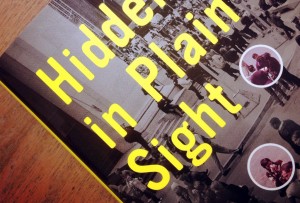 So far the debate over how much impact the gas industry has had on DFW air quality has centered on the Barnett Shale. That's logical because that's the gas play right in front of us, in the middle of the North Texas "non-attainment area" for smog. One of the main arguments Rick Perry's Texas Commission on Environmental Quality has made against any significant impact is that most of the drilling is happening west of the DFW urban centers.
So far the debate over how much impact the gas industry has had on DFW air quality has centered on the Barnett Shale. That's logical because that's the gas play right in front of us, in the middle of the North Texas "non-attainment area" for smog. One of the main arguments Rick Perry's Texas Commission on Environmental Quality has made against any significant impact is that most of the drilling is happening west of the DFW urban centers.
Ignoring how geographically-incorrect this argument is – there's drilling and compressors in Dallas County right now, much less Ellis, Johnson. Denton and Tarrant – let's just cede the argument to the state that it would take gas fields to the Southeast of us, that is, upwind of us during ozone season, to really impact our air quality.
Guess what? There's gas fields Southeast of DFW that are producing lots of air pollution.
In previous posts over at least the last two years, we've shown that if you add up the standard permits of all the gas compressors in Freestone County alone, they represent more smog pollution than the Big Brown Coal Plant doing business down the road. Now there's new evidence of the size of these gas fields and their relationship to the DFW airshed, thanks to Google.
Here's a picture of the area we're talking about – just about an hour and a half drive southeast of DFW, east of Waco. That makes it directly upwind during ozone seasons.
When you zoom into where the green arrow is, you see the familiar sight of hundreds of square drilling pads laid out over the landscape – just like the Barnett Shale – only DFW is directly downwind of it during the summer.
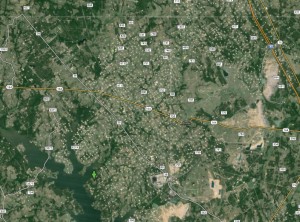 Pollution from these sources has most likely been grossly underestimated by the state. Moreover, when gas field pollution comes into an urban area with dirty air, it increases the likelihood of that pollution turning into smog. Rick Perry's employees are loath to admit the gas industry plays any part in the stagnation of DFW air quality progress since 2007, but as these images make clear, facts on the ground trump their ideology.
Pollution from these sources has most likely been grossly underestimated by the state. Moreover, when gas field pollution comes into an urban area with dirty air, it increases the likelihood of that pollution turning into smog. Rick Perry's employees are loath to admit the gas industry plays any part in the stagnation of DFW air quality progress since 2007, but as these images make clear, facts on the ground trump their ideology.
9 Days Until the End of the Dallas Gas Wars: What You Can Do
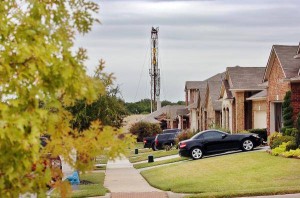 We only have 9 days to protect what it's taken us at least the last 12 months to build. The final Dallas City Council vote on a new gas drilling ordinance will take place on Wednesday, December 11th.
We only have 9 days to protect what it's taken us at least the last 12 months to build. The final Dallas City Council vote on a new gas drilling ordinance will take place on Wednesday, December 11th.
THIS WEDNESDAY – Tomorrow
December 4th
1 pm
Dallas City Council Mtg.
Dallas City Hall 6th Floor
Public Comment Being Taken on New Gas Drilling Ordinance
NEXT WEDNESDAY
December 11th
1 pm
Dallas City Council Mtg.
Dallas City Hall 6th Floor
Public hearing and VOTE on new Gas
Gas Drilling Ordinance
If you've come to City Hall on this issue recently, thank you, but we need you to show up again in the next two weeks and make sure our previous victories remain intact.
If you haven't shown up yet, or it's been a while, we really need some fresh faces to speak up and support the strongest ordinance we can get.
What's at Stake:
The 1500-foot buffer zone between drilling and compressor stations and neighborhoods.
This 1500-foot "setback" was supported by a 14-1 vote of the City Plan Commission in its recommendations to the City Council. It applies not only to gas drilling sites, but to large compressor stations too.
Flower Mound has a 1500-foot setback. The Lubbock Health Board has recommended a 1500-foot setback for that city. Denton has just voted for a 1200-foot setback.
Yet at least six city council members (Jerry Allen, Sheffe Kadane, Vonciel Hill, Tenell Atkins, Lee Kleinman, and Rick Callahan want to rollback that distance to allow drilling and compressor stations within just 1000 feet of neighborhoods and schools, and with "variances," as close as 500 feet.
Recently, old wells were activated in Denton that are as close as 600 feet to homes that were built since the leases were granted. According to press coverage last week, "residents in the Vintage neighborhood were not happy when they noticed "vibrations, noise and glare" about 600 feet from their homes…."
The disruption was so great that the City of Denton sued the gas drillers. "The actions of the Defendants are causing immediate and irreparable harm," the city's lawsuit said.
The Politics:
This is the kind of heavy industry these six city council members want to bring to Dallas neighborhoods, and they'll succeed if they can get Mayor Rawlings, Jennifer Gates and/or Dwaine Caraway to agree with them.
The rest of the council has made up its mind. It's the six backers of industry listed above vs. the six council members who voted to reject the Trinity East permits (Scott Griggs, Philip Kingston, Monica Alonzo, Adam Medrano, Sandy Greyson, and Carolyn Davis). Any motion needs 8 vote to win.
That's why these three Council members – Mayor Rawlings, Jennifer Gates, and Dwaine Caraway – will determine whether Dallas gets a more, or less protective gas drilling ordinance.
Mayor Rawlings has gone on record as opposing gas drilling in Dallas on principle. He's also gone on record saying he'd support the CPC recommendations. We need to make sure he keeps his word. He should be leading the charge for the most protective ordinance we can get.
Jennifer Gates ran on a platform of keeping drilling out of neighborhoods. We need to remind her of that and that she too needs to be leading the fight to keep the 1500 foot setback.
Dwaine Carway needs to be reminded that gas drilling is an environmental justice issue that will disproportionately hurt low income and minority areas of Dallas.
WHAT YOU CAN DO TO HELP:
1) Attend one or both of the next City Council meetings and ask the Council to pass the draft gas ordinance that the City Plan Commission recommended, including the 1500 foot setback.
2) If you haven't already, click here and send the Mayor a quick "click n' send" e-mail asking him to keep his word and support the Plan Commission recommendations iin total, including the 1500 foot setback. Please do this asap.
(We've added the e-mail addresses of both Jennifer Gates and Dwaine Carraway to the message to make sure they know how you feel.)
3) Contact Mayor Rawlings, Jennifer Gates and Dwaine Caraway on your own:
Mayor Rawlings
mike.rawlings@dallascityhall.com
Adam McGough, Chief of Staff
Phone: 214-670-7894
Dwaine Caraway
dwaine.caraway@dallascityhall.com,
214-670-0781
Jennifer Gates
Jennifer.gates@dallascityhall.com
Phone: 214-670-3816
4) Stay Tuned. They're more actions being planned leading up to the 11th so you can express your support for a strong ordinance. Keep on the lookout in your e-mailbox for alerts and on line here on the Downwinders' blog.
Scientific Support For a 1500-foot Setback
The 2012 Colorado School of Public Health study of cancer and non-cancer risks in the gas field, entitled "Human health risk assessment of air emissions from development of unconventional natural gas resources." This study concluded that residents living within a half-mile of a gas well had a 66% higher incidence of cancer than those living further away from a well.
The 2013 Emory University study found the risk of developing non-Hodgkin lymphoma increased among those living in proximity to facilities that release benzene. Natural gas facilities can release a lot of Benzene.
A 2012 report from Cornell University found that a mother's exposure to fracking before birth increases the overall prevalence of low birth weight by 25 percent.
Another 2012 Cornell University study that focused on animal health in the gas field concluded that reduced milk production, gastrointestinal, neurological, urological issues and sudden death are just a few of the symptoms experienced by livestock living near natural gas fracking sites.
Dr. Vikas Kapil of the National Center for Environmental Health at the U.S. Centers for Disease Control and Prevention gave a presentation in January 2012, saying "We do not have enough information to say with certainty whether shale gas drilling poses a threat to public health."
In addition, the Army Corp of Engineers recommends a distance of 3000 feet between structures like dams and levees and gas wells because of the danger of vibrations to structural integrity. If this distance is good enough for a dam, it's good enough to protect a home's foundation.

